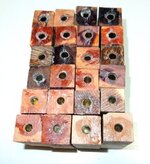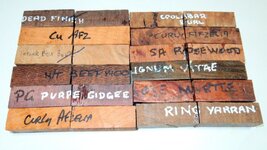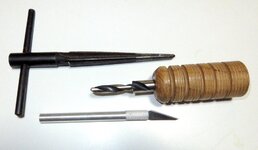Thank you all!
All of the responses have been greatly appreciated. Hi to my dear friend Peter, who uses a similar glue and procedure as I do.
Terry's, Lou's and Louie's responses that they get rid of glue when it is too thick and hard to pour really hit a chord with me. That is when my first inkling that a problem might surface. I also liked Mark's suggestion of dating and getting rid of it after a year. When I was using epoxy, I bought a 8 ounce bottles of T-88 because it was very strong. I don't know what I was thinking! I wouldn't use that up in 3 lifetimes...
Hank wanted a report of my use of White Gorilla Glue. I scuff the tubes, and I do use just the lightest amount of water inside the blanks; applied with a LIGHTLY moistened q-tip. Careful here with some wood blanks, because depending on the species, they can swell up to the point you have to redrill! I have experienced that only once, but once was enough!
I plug both ends of the tube with Plumber's Putty which has been flattened out on a piece of waxed paper. Supplies on hand before I begin: two popsicle sticks to clean off the ends of the tubes; a spare tube to move the glued tube where I want it inside the blank; roll of blue tape to go around the glued up blank a couple of times end to end; nitrile gloves; a couple of paper towels to clean up the mess; another piece of waxed paper to set the glued up blanks on when they are done.
The glue is applied in two lines down 3/4 of the tube and the tube is put into the blank. When it it a 2 piece blank, I start on the end opposite of where the two should match up. Twist, in and out, twist, in and out, then remove it and apply glue to the remaining side and put it in the opposite end. Same twist, in and out, etc.
I cut my blanks about 1/8" long on both ends, so I use a sacrificial tube to get just the right amount of blank on the matching end of the tubes to be able to sand down using Rick Herrell's Offset sanding jig (GREAT TOOL!!!). I wrap the blank with blue tape and let it set for several hours before I unwrap it and use an appropriately sized steel pin to push the Plumber's Putty out and clean up what is left behind with an exacto blade and round brush.
I have NEVER had a failure with this glue. I experience difficulties with CA (only once or twice) when I tried to glue the tube in when the acrylic blank was warm from drilling and the glue seized when the tube was half way in.
This is certainly more detail that anyone wanted, but I really appreciate the help I get on this forum, and if I have given anyone an idea, I am happy to do so.
I am off to buy a new small bottle of glue!



